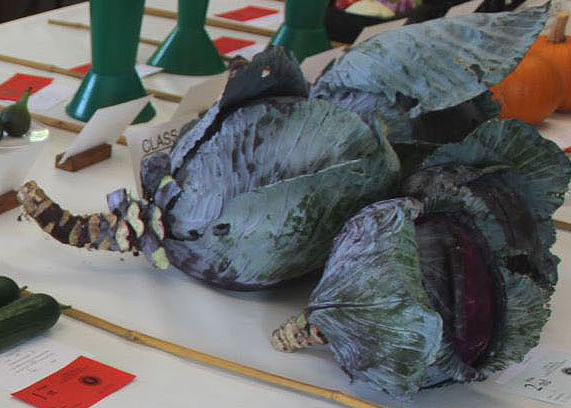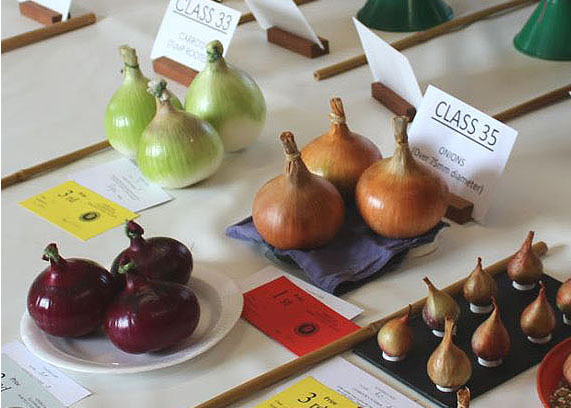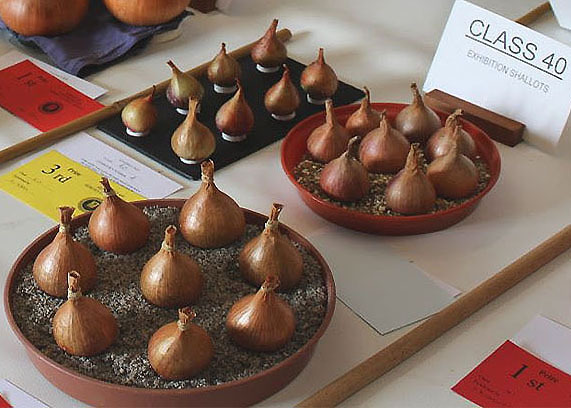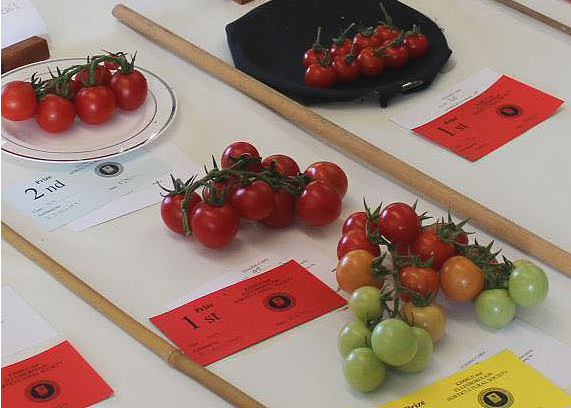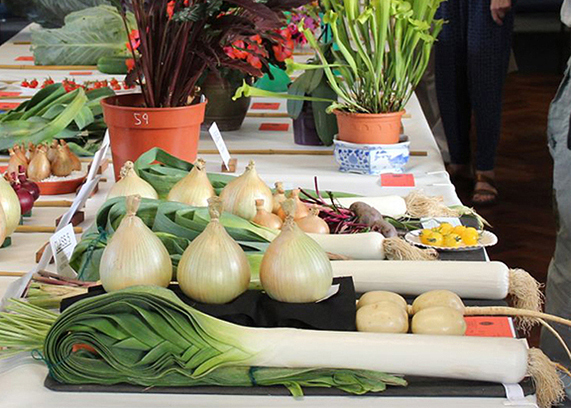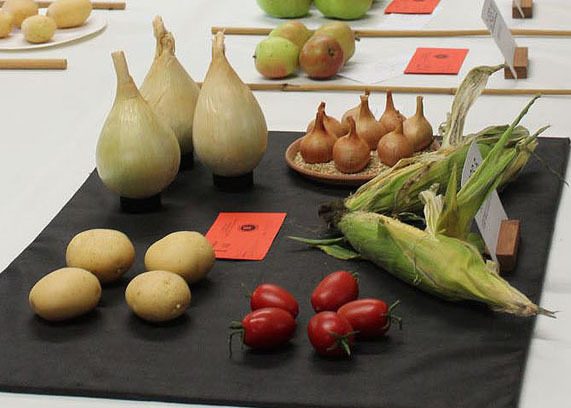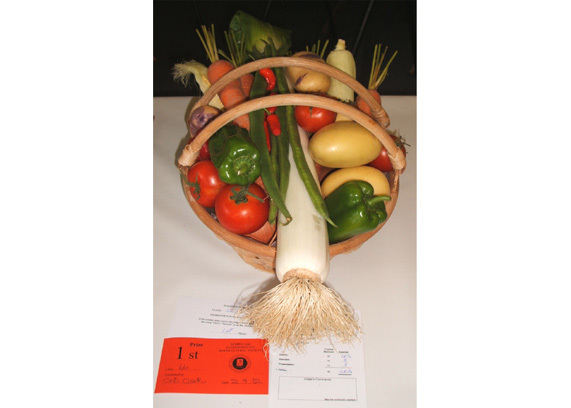Print pdf for Guide to Vegetables
Our vegetable classes have something for all levels of exhibitors but, if you are new to showing, you may find this information useful.
We have a wide variety of vegetable classes,including classes for novices.
Our classes are judged in accordance with the rules for the National Vegetable Society.
The factors determining the number of points awarded may vary. They normally include most but not necessarily all of the following: condition, uniformity, size, shape and colour.
You will find more information about pointing and the scale of points for the most common vegetables at the end of the guide.
GENERAL TIPS FOR EXHIBITORS
Make sure you read the Show Schedule carefully, noting the requirements for each class including the number of specimens stipulated and any requirements re size and their display.
Failure to display the number of specimens required for the class is a common reason for the exhibit being classed as NAS (not according to schedule).
Try and ensure that your specimens for the class are a uniform shape and size. Large specimens may be desirable but this should not be at the expense of uniformity and quality.
They should be in as good a condition as possible, ie unbroken skins and free of blemishes, pest damage and disease.
Vegetables should have a fresh colour and the shape should be typical for the cultivar.
They should be carefully cleaned to avoid any damage. Try to preserve the natural bloom. They should not be oiled.
Exhibits will consist of one variety, unless otherwise specified in the schedule.
Try to display them as attractively as possible in accordance with the rules and schedules. For example, beans are traditionally arranged in a straight line and carrots in a fan while radishes look good in a wheel.
Where possible, it’s a good idea to take a few extra specimens in case of mishaps.
When assessing the exhibits, judges may, for example, snap pea and bean pods to check the quality.
Some varieties are particularly suited to exhibition and you may find the RHS recommendations for growing vegetables for exhibition useful.
If you have any queries please contact the Show Secretary before the Show.
GENERAL RULES AND TIPS FOR VEGETABLES
The following information is based on the National Vegetable Society’s guide to exhibition. It is a selection of useful tips on what to look out for or avoid for a variety of vegetables. It can only be a summary and information about, for example, the need for freshness and colour and shape being appropriate for the cultivar should be taken as a given.
Beans – Broad: Pods should be well -filled and without gaps between the beans which should still be attached to the pod. Display direct on the bench or on a plate. They should all face the same way.
Beans - French, Climbing or Dwarf: Straight, fresh pods with stalks intact and uniform tails. There should not be any outward sign of seeds. Display with the tails pointing the same way.
Beans - Runner: Pods should be long and straight with stalks and no outward sign of prominent seeds. Display as above.
Beetroot - Globe: They should have a single firm taproot with the smooth skin and a colour and shape appropriate to the cultivar. They should be about the size of a tennis ball. The foliage should be trimmed to approximately 75mm.
Beetroot - Long or Cylindrical: Long beetroot should have firm well-shaped tap roots and be free of side roots and growths. They should be evenly tapered with round symmetrical shoulders and with a good weight down the full length. Cylindrical beetroot should have straight roots and finish with a stump/bull nose and be about 100-150mm long. The foliage of both should be trimmed to approximately 75mm.
Cabbages: Cabbages should have shapely and solid heads with turgid surrounding leaves and the bloom intact. They should have about 75mm of stalk.
Calabrese: The heads should be firm with a good shape and without loose side spears. There should not be any signs of flowering.
Carrots: Long-pointed carrots should have firm, straight, long and smooth roots with no splits. Tap roots should be intact without side roots or other blemishes. Stump-rooted carrots should have a definite stump (blunt end) and an intact tap root. There should be no greening of the shoulders. Foliage of both should be trimmed to about 75 mm.
Cauliflowers: The heads should have symmetrical close, solid white curds with about 75 mms of stalk and foliage neatly trimmed to reveal the curd. Viewed from above it should be circular and from the side it should have a medium shaped dome. The diameter should be around 200 mm.
Celery: Blanched or trenched celery should be medium to large and well-matched. Also, well blanched with firm crisp leaf stalks (petioles), dark green foliage and no signs of heart rot. Self-blanching or American green celery should also be as above.
Courgettes: Young, tender fruits with a good shape and colour, about 150mm long and about 25-35mm in diameter. Round cultivars should be about 75mm in diameter. They can be of any colour but should be well matched. They can be shown with or without flowers.
Cucumbers – glass and grown out of doors: They should have young, firm, green, straight fruits of uniform thickness with short handles (ie the portion of the fruit closest to the stems) and unmarked skin with its natural bloom. They are preferably shown with flowers still attached but this is not essential.
Leeks: The barrel should be firm with no split skins or signs of bulbing or ribbing and should be similar in size. The root plate should be intact. The buttons should be tight. When presenting, the roots should be left on but cleaned. The flags (foliage) should also be left but can be tied neatly with raffia in several places.
Lettuce – butterhead, cos, crisp and loose-leaf: Heads should be well-matched with a firm heart, clean and dry. Roots should be washed, wrapped in moist tissue and then placed in a plastic bag to keep them fresh. The hearts should face the front of the bench.
Marrows: They should be fresh and young. They should be less than 350mm in length or, if round, should be about 500mm in circumference.
Onions – 75mm diameter or less: Firm with similar shape and colour with roots trimmed back to the basal plate and tied with natural raffia.
Onions – over 75mm diameter: Size should ideally be 100mm or more. Otherwise the merits and presentation should be as for the small onion class.
Onions – green salad: The tender leaves should have white stems with no bulbing at the base. The tips should not be trimmed.
Parsnips: Should be well-grown with a good white colour, firm and straight. They should have round symmetrical shoulders and a good uniform weight down the full length. The foliage should be trimmed to about 75mm.
Peas – mangetout or snap: Pods should be young with the bloom intact. Freshness is key so they should not be overdeveloped.
Peas: Large, long pods with bloom intact and with stalks, calyx and stigma intact. The pods should be well filled with tender peas. Presentation is usually in a row with all stalks trimmed to an even length. Handle by the stalk to help preserve the natural bloom.
Potatoes: Potatoes should ideally weigh 200-250 grams and be of equal size and shape. They should be well-shaped and free of blemishes with unbroken skin and shallow eyes. For presentation they should be carefully washed. They must not be polished.
Pumpkins: Pumpkins should be shapely and firm with a good colour and the stalk attached.
Radishes, salad: They should have firm, young, tender and well-coloured roots. The foliage is usually trimmed to about 30mm.
Radishes – oriental or winter: Fresh roots, well-coloured in accordance with the cultivar. The foliage should be cleaned but not removed.
Saladings: These should be young, fresh, clean and attractive. Please see the Definitions in the KEHS year book for a list of vegetables that may be used as Saladings. You can also add other vegetables that would be used in a salad.
Shallots – exhibition: Each should be a good sized “single bulb” with a circular outline with no signs of dividing, well ripened and free from greening or purpling at the base. The roots should be neatly trimmed and necks tied with natural raffia. They are best presented on dry silver sand.
Shallots – pickling: Each specimen should be a single spherical bulb without flat sides or evidence of dividing. They should be without greening or purpling and with neatly trimmed roots and neatly tied necks with natural raffia. Each bulb must pass freely through a 30mm ring gauge. Display as above.
Squashes: These should be as Pumpkins.
Sweet Corn: The cobs should be fresh and cylindrical, of good length and with well-set grains throughout to the tip, with straight rows of undamaged plump, tender grains and fresh green husks with the silk still attached. A narrow strip of the husk should be removed to expose the grain shortly before judging.
Tomatoes – medium: They should be approx. 60mm in diameter, well-shaped, rounded, ripe but firm. Colour should be appropriate to the cultivar. The calyces must be attached.
Tomatoes – large (beefsteak type): Fruits should not be less than 75mm in diameter and not green-backed. Otherwise as medium tomatoes.
Tomatoes – small/cherry: The size should not exceed 35mm in diameter and they should be shaped according to cultivar. Otherwise the merits are as medium and large.
Tomatoes - truss: The truss should not have any missing fruits and should gradually reduce or taper down from ripe edible fruits to a number of smaller immature unripe fruits. Ideally at least 1/3 of the fruit should be fully ripe. Trusses can be single or double.
Turnips: They should be clean, clear skinned solid shapely roots with small single taproots with size, shape and colour appropriate to the cultivar.
VEGETABLE COLLECTIONS
The NVS has three types of vegetable collections - large, mini and trug or basket.
You can see some examples in the Image Gallery.
We have various classes that fit into these categories as below:
Large Collection
NVS description: They normally have 5 kinds of vegetables and are the centre piece of the show. There should not be two of the same kind of vegetable eg long and stump rooted carrots. To gain the maximum points, try to exhibit vegetables with the highest points value.
Class 5 – Collection of 5 distinct kinds of vegetables as per class 31-61: Presentation requirements: width allowed 600mm, a tray, board or fabric base coloured black should be used.
Mini Collection
NVS description: These ask for 1 or 2 specimens of a cultivar from 3 to 5 kinds.
Class 63 – Collections of 5 single kinds of vegetables. Presentation requirements - displayed in a standard seed tray, exhibits must NOT overhang the sides of the tray
Class 64 – Collections of 4 kinds of saladings. Presentation requirements - 2 of each, width allowed for staging: 450mm.
Class 80 (Novices) - Collections of 3 single kinds of vegetables. Presentation requirements - width allowed for staging: 450mm.
Basket
NVS description: The composition can be very varied so careful consideration of both the pointing schedule and the size of the container is important to select the best options.
Class 66 – Basket of Mixed Vegetables. Presentation requirements: maximum dimensions 600mm x 300mm
(See Definitions and Vegetable Pointing for more information).
POINTING FOR VEGETABLES
Pointing is simply the system used to allocate the maximum available points in a class. KEHS uses the National Vegetable Society pointing system.
The number of points available depends on the difficulty of growing and presenting the produce.
Points are awarded on a number of factors. These may vary - they normally include most but not necessarily all of the following:
- Condition
- Uniformity
- Size
- Shape
- Colour
The total number of points available varies depending on the class so, for example, you can only achieve a maximum of 12 points for your cherry tomatoes or courgettes but you could get 20 points for your potatoes, leeks or parsnips.
Scale of Points for Vegetables
|
Vegetable |
Points |
Vegetable |
Points |
|
Beans, broad |
15 |
Marrows |
15 |
|
Beans, French |
15 |
Onions, over 75mm diameter |
20 |
|
Beans, runner |
18 |
Onions, green salad |
12 |
|
Beetroot, globe |
15 |
Onions, 75mm diameter or less |
15 |
|
Beetroot, long |
20 |
Parsnips |
20 |
|
Cabbage |
15 |
Peas |
20 |
|
Calabrese |
18 |
Peas, Mangetout or Snap |
15 |
|
Carrots, pointed |
20 |
Potatoes |
20 |
|
Carrots, stump rooted |
18 |
Radishes, small salad |
10 |
|
Cauliflowers |
20 |
Radishes, oriental or winter |
15 |
|
Celery, all other |
18 |
Shallots, exhibition |
18 |
|
Celery, trench |
20 |
Shallots, pickling |
15 |
|
Courgettes |
12 |
Sweet Corn |
18 |
|
Cucumber, glass |
18 |
Tomatoes, large |
15 |
|
Cucumber, outdoor |
15 |
Tomatoes, medium |
18 |
|
Leeks |
20 |
Tomatoes, small/cherry |
12 |
|
Lettuce |
15 |
Tomatoes, truss |
15 |
|
|
|
Turnips |
15 |
Pointing for Vegetable Collections
|
Type of Collection |
Pointing |
| Large | Points are variable as they are awarded according to the maximum for each vegetable entered. |
| Mini | As above. |
| Basket |
Quality - 20 points Variety - 20 points Presentation - 20 points Total - 60 points |
OTHER SOURCES OF INFORMATION
Judges and Exhibitors Guide - The National Vegetable Society
The Horticultural Show Handbook: The official RHS guide to organising, judging and competing in a show – Royal Horticultural Society
Great British Village Show – Royal Horticultural Society
RHS website Vegetables for Exhibition RHS Vegetables for Exhibition

